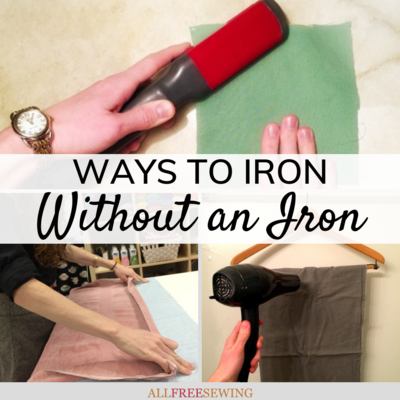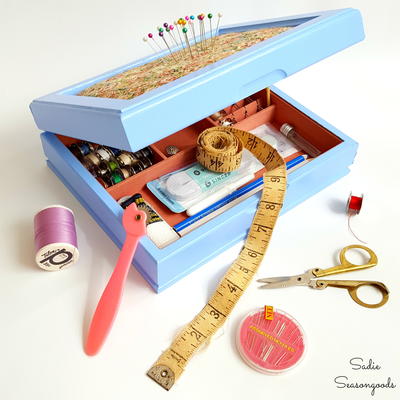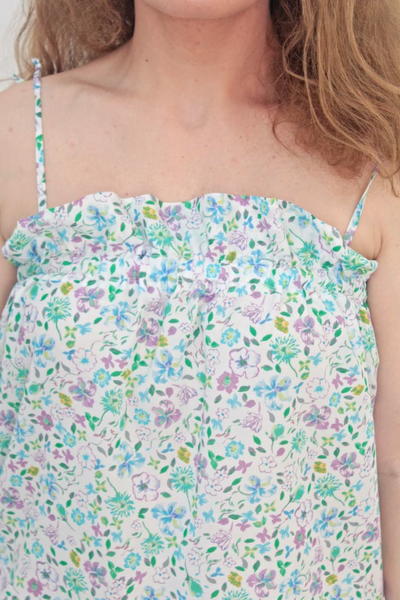Modern Mending Lesson 2
 This tutorial shows a method for repairing holes in jeans, how to lengthen a dress or skirt, and demonstrates reverse applique for a stained or torn shirt.
This tutorial shows a method for repairing holes in jeans, how to lengthen a dress or skirt, and demonstrates reverse applique for a stained or torn shirt.
If you have children, we know you're going to run into these upcycling issues. Don't be caught off-guard and learn how to fix them.
Give modern mending a try and keep creating the free sewing projects you love. Visible mending is also a big trend and so it's a good skill to have whether you are actually fixing an item of clothing or want to add some textural elements to your new clothes or other fabric pieces.
If you're a visual learner, then make sure you watch Maureen Wilson's video tutorial found at the bottom of this page, too.
Sign Up For More Free Patterns >>>
Along with this lesson, be sure you check out Modern Mending Lesson 1 and Modern Mending Lesson 3.

Lengthening a Dress or Skirt
If you find yourself always tugging at the hem of your skirt, then consider adding a couple inches of length with this method. You'll be much more comfortable!
Materials:
- Dress or skirt that's too short
- Trim (lace, ribbon, tulle, etc.)
- Seam ripper
- Pins
- Thread to match dress
- If you have a skirt or dress that's a bit too short, the first thing you should do is inspect the hem. You might get lucky, and find a generous hem, like on this skirt. If that's the case, unpick the original hem, then press and sew a new, smaller hem.
- If the original hem isn't large enough, you can lengthen it by adding trim, such as lace, tulle, or ribbon. I found this trim at JoAnn Fabric, and it will add both length and interest to this dress. Pin the trim on the interior of the dress, using the original stitches as a guide to keep your new hem straight.
- If your garment is tight at the hem and needs to stretch (like a mini skirt), use a zig-zag stitch or serger. If it flares at the hem, you can use a straight stitch. Be careful not to stretch the fabric while you sew.

Contrast Darning for Jeans
Here's a method for mending holes in jeans, that's more stylish than the iron-on denim patches your mother used.
Materials:
- Jeans with holes
- Denim scrap
- Contrasting color of thread
- I bought these jeans for my daughter at Old Navy, and they came with cute contrast stitch detailing over frayed areas. I'm going to mimic that style on another pair of her jeans that she's worn out.
First you'll need to cut a small scrap of denim to reinforce the area. I'm using a piece from a pair of jeans that I turned into shorts. - Don't worry if it doesn't match the color exactly. Insert your hand into the leg of the jeans, and pin the denim scrap beneath the hole.
- I happen to have an Automatic Darning stitch on my sewing machine. If you don't, that's okay. You'll just sew with a straight stitch, then backstitch, then stitch forwards again to make a tall, tight zig-zag pattern. Use a contrasting thread for interest. Be sure you're only sewing through one layer of the pants.
- You'll need to add at least one other stitched area, or the first will look out of place. Be careful that you don't sew the pockets shut. If the back pockets are large enough to slide onto the arm of your sewing machine, you can add decorative stitching to the top layer of a back pocket as well.

Reverse Applique Technique
If your child's shirt has a small rip or stain, don't throw it out. Try creating a reverse applique instead.
Materials:
- Shirt with hole or stain
- Scrap shirt in similar material
- Fabric adhesive spray
- Lightweight interfacing
- I keep a clear blanket storage bag full of old t-shirts I can cut up to use while mending or refashioning. You'll need a garment that's made from the same type of material as the shirt you're mending. (For example, if it's a t-shirt, you'll need a knit. If it's a cotton shirt, pair it with another cotton.)
- Use a water-soluble pen to trace or free-hand a shape over the damaged area of the shirt. I'm doing a heart, but a star, bird, or butterfly would be cute as well. Cut out the shape, being careful to cut through only one layer of fabric.
- Then cut out a scrap of fabric from the spare shirt you're using. I like to use fabric adhesive spray for this next step, because it keeps the knit fabrics from stretching as you sew. Turn the t-shirt inside out, and slide a piece of scrap cardboard between the layers. Spray around the edge of the cut-out shape.
- Then press the fabric scrap on top of the cut out, and immediately remove the cardboard. Allow the fabric to sit for a few minutes so the glue won't gum up your machine.
- Next, cut a scrap of thin interfacing and place it behind the fabric scrap. This will stabilize the shape and keep it from warping. Pin or iron it in place.
- Then, turn right side out, and sew around the shape. Be sure you're sewing through one layer only. You can do a zig-zag stitch that overlaps both fabrics, or you could do a straight stitch with a 1/8 inch seam. If you do the straight stitch, the fabric cut-out will curl slightly in the wash, giving the shape interesting textured layers.

Watch the video tutorial here:


![Know Your Pants Guide [Infographic]](http://irepo.primecp.com/2022/07/530206/Know-Your-Pants-Infographic-square21-nw_Large400_ID-4831184.png?v=4831184)













